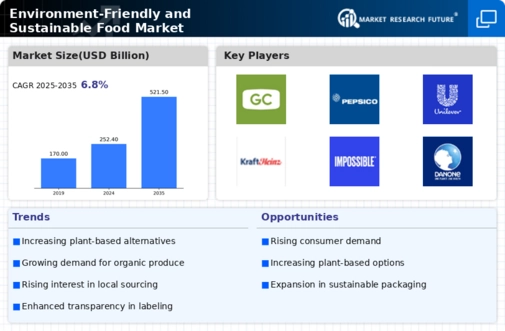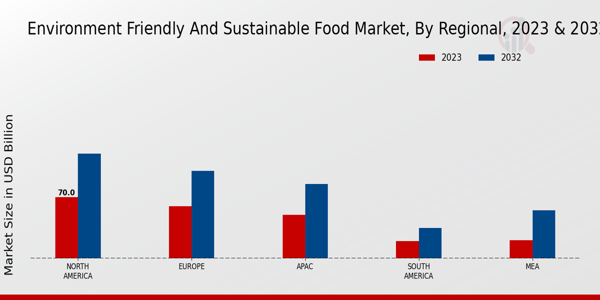Market Growth Projections
The Global Environment-Friendly and Sustainable Food Market Industry is on a trajectory of substantial growth, with projections indicating a market value of 252.4 USD Billion in 2024 and an anticipated increase to 521.5 USD Billion by 2035. This growth is underpinned by a compound annual growth rate (CAGR) of 6.82% from 2025 to 2035. Such projections reflect the increasing consumer demand for sustainable food options and the ongoing commitment of producers to adopt environmentally friendly practices. The market's expansion is likely to be influenced by various factors, including technological advancements, regulatory support, and evolving consumer preferences.
Rising Consumer Awareness
The Global Environment-Friendly and Sustainable Food Market Industry experiences a notable surge in consumer awareness regarding health and environmental impacts of food choices. As individuals become increasingly informed about the benefits of sustainable practices, demand for organic and eco-friendly products rises. This trend is evidenced by the projected market value of 252.4 USD Billion in 2024, reflecting a growing preference for foods that minimize ecological footprints. Consumers are actively seeking products with transparent sourcing and minimal processing, which indicates a shift towards more responsible consumption patterns. This heightened awareness is likely to drive innovation and sustainability in food production.
Government Initiatives and Regulations
Government initiatives play a crucial role in shaping the Global Environment-Friendly and Sustainable Food Market Industry. Various countries are implementing policies aimed at promoting sustainable agriculture and reducing carbon emissions associated with food production. For instance, subsidies for organic farming and regulations on pesticide use are becoming more common. These measures not only encourage farmers to adopt sustainable practices but also enhance consumer confidence in eco-friendly products. As a result, the market is expected to grow significantly, with projections indicating a value of 521.5 USD Billion by 2035. Such regulatory frameworks are essential for fostering a sustainable food ecosystem.
Increased Demand for Plant-Based Foods
The Global Environment-Friendly and Sustainable Food Market Industry is witnessing a marked increase in demand for plant-based foods. This trend is driven by a combination of health consciousness and environmental concerns, as consumers seek alternatives to traditional animal-based products. The rise of veganism and flexitarian diets is indicative of this shift, with many individuals opting for plant-based options to reduce their carbon footprint. This growing preference is expected to contribute to the market's expansion, aligning with the projected growth to 521.5 USD Billion by 2035. The plant-based food sector is likely to innovate continuously, offering diverse products that cater to evolving consumer tastes.
Sustainability Certifications and Labels
Sustainability certifications and labels are becoming increasingly influential in the Global Environment-Friendly and Sustainable Food Market Industry. These certifications provide consumers with assurance regarding the environmental and ethical standards of food products. Labels such as USDA Organic and Fair Trade are gaining traction, as they signify adherence to sustainable practices. This trend not only enhances consumer trust but also encourages producers to adopt environmentally friendly methods. As more consumers prioritize certified products, the market is poised for growth, potentially reaching a value of 252.4 USD Billion in 2024. The proliferation of these certifications may further drive the demand for sustainable food options.
Technological Advancements in Agriculture
Technological advancements are transforming the Global Environment-Friendly and Sustainable Food Market Industry by enhancing agricultural efficiency and sustainability. Innovations such as precision farming, vertical agriculture, and biotechnology are enabling farmers to produce food with reduced environmental impact. For example, precision agriculture utilizes data analytics to optimize resource use, thereby minimizing waste and improving yields. This shift towards technology-driven solutions is likely to attract investments and support the market's growth, with a projected CAGR of 6.82% from 2025 to 2035. As these technologies become more accessible, they may significantly reshape food production practices globally.
























